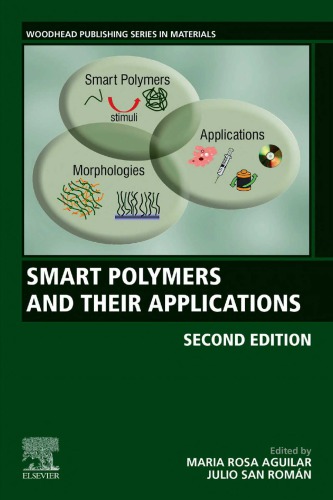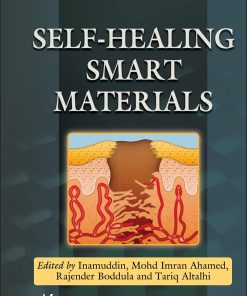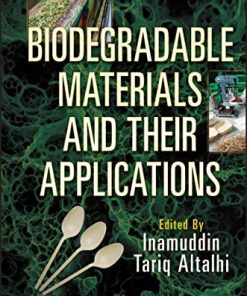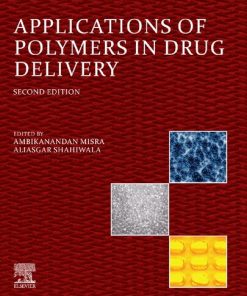Smart Polymers and Their Applications 2nd Edition by Aguilar Maria Rosa 0081024171 9780081024171
$50.00 Original price was: $50.00.$25.00Current price is: $25.00.
Smart Polymers and Their Applications 2nd Edition by Aguilar Maria Rosa – Ebook PDF Instant Download/DeliveryISBN: 0081024171, 9780081024171
Full download Smart Polymers and Their Applications 2nd Edition after payment.

Product details:
ISBN-10 : 0081024171
ISBN-13 : 9780081024171
Author : Aguilar Maria Rosa
Smart Polymers and Their Applications, Second Edition presents an up-to-date resource of information on the synthesis and properties of different types of smart polymers, including temperature, pH, electro, magnetic and photo-responsive polymers, amongst others. It is an ideal introduction to this field, as well as a review of the latest research in this area. Shape memory polymers, smart polymer hydrogels, and self-healing polymer systems are also explored. In addition, a very strong focus on applications of smart polymers is included for tissue engineering, smart polymer nanocarriers for drug delivery, and the use of smart polymers in medical devices.
Additionally, the book covers the use of smart polymers for textile applications, packaging, energy storage, optical data storage, environmental protection, and more. This book is an ideal, technical resource for chemists, chemical engineers, materials scientists, mechanical engineers and other professionals in a range of industries.
Smart Polymers and Their Applications 2nd Table of contents:
Chapter 1: Introduction to Smart Polymers and Their Applications
Abstract
Acknowledgment
1.1 Types of Smart Polymers
1.2 Applications of Smart Polymers
1.3 Conclusions
Chapter 2: Temperature-Responsive Polymers: Properties, Synthesis, and Applications
Abstract
2.1 Introduction: The Role of Temperature-Responsive Polymers
2.2 Basic Principles of Temperature-Responsive Polymers in Aqueous Solution
2.3 Key Types of Temperature-Responsive Polymers in Aqueous Solution
2.4 Selected Applications of Thermoresponsive Polymers
2.5 Conclusions: Strengths and Limitations of Current Temperature-Responsive Polymers
2.6 Future Trends
Chapter 3: pH-Responsive Polymers: Properties, Synthesis, and Applications
Abstract
3.1 Introduction
3.2 Basic Principles of pH-Responsive Polymers
3.3 Key Types and Properties of pH-Responsive Polymers
3.4 Synthesis of pH-Responsive Polymers
3.5 Application
3.6 Conclusions and Future Trends
Chapter 4: Photoresponsive Polymers
Abstract
4.1 Introduction
4.2 Chromophores and Their Light-Induced Molecular Response
4.3 Key Types and Properties of Photoresponsive Polymers
4.4 Applications
4.5 Conclusions and Future Trends
Chapter 5: Enzyme-Responsive Polymers: Classifications, Properties, Synthesis Strategies, and Applications
Abstract
5.1 Introduction
5.2 Historical Evolution of Enzyme-Responsive Polymer
5.3 Enzyme-Responsive Materials
5.4 Properties of Enzyme-Responsive Polymers
5.5 Fabrication Mechanisms of Enzyme-Responsive Polymers
5.6 Applications of Enzyme-Responsive Polymers
5.7 Conclusion
Chapter 6: Conductive Poly(3,4-Ethylenedioxythiophene) (PEDOT)-Based Polymers and Their Applications in Bioelectronics
Abstract
Acknowledgments
6.1 Introduction
6.2 Polymerization of Ethylenedioxythiophene (EDOT-ProDOT) Monomers
6.3 PEDOT-Based Aqueous Dispersion
6.4 Applications of Innovative PEDOT-Based Materials
6.5 Conclusions
Chapter 7: Inflammation-Responsive Polymers
Abstract
7.1 Introduction
7.2 Inflammatory Microenvironment
7.3 Key Types and Properties of Inflammation-Responsive Polymers
7.4 Current and Future Trends
7.5 Conclusions
Chapter 8: Dual- and Multistimuli-Responsive Polymers for Biomedical Applications
Abstract
8.1 Introduction
8.2 Dual Responsive Polymers and Their Applications
8.3 Multiresponsive Polymers and Their Applications
8.4 Conclusions and Future Trends
Chapter 9: Smart Polymer Gels: Properties, Synthesis, and Applications
Abstract
9.1 Introduction
9.2 Key Types, Properties, and Applications of Smart Hydrogels
9.3 Conclusions and Future Trends
Chapter 10: Stimuli-Responsive Protein Fibers for Advanced Applications
Abstract
10.1 Peptide-Based Fibrous Systems
10.2 Silks-Based Fibers
10.3 Elastin-Based Smart Materials
10.4 Conclusions and Future Trends
Chapter 11: Self-Healing Polymeric Systems: Concepts and Applications
Abstract
Acknowledgments
11.1 Introduction
11.2 Existing Healing Approaches
11.3 Functionality Restoration
11.4 Concluding Remarks
Chapter 12: Smart Instructive Polymer Substrates for Tissue Engineering
Abstract
12.1 Introduction
12.2 Instructive Polymeric Surfaces
12.3 Instructive Hydrogels With a Physicochemical Response
12.4 Materials With 3D-Defined Patterns
12.5 Applications in Tissue Engineering
12.6 Conclusion and Future Trends
Chapter 13: Smart Polymeric Nanocarriers for Drug Delivery
Abstract
13.1 Introduction
13.2 Smart Polymeric Carriers for Drug Delivery: pH-Responsive Nanocarriers
13.3 Smart Polymeric Carriers for Drug Delivery: Enzyme-Responsive Nanocarriers
13.4 Smart Polymeric Carriers for Drug Delivery: Oxidation-Responsive Nanocarriers
13.5 Smart Polymeric Carriers for Drug Delivery: Temperature-Responsive Nanocarriers
13.6 Smart Polymeric Carriers for Drug Delivery: Nanocarriers Responsive to Other Stimuli
13.7 Conclusion and Future Trends
Chapter 14: The Use of Smart Polymers in Medical Devices for Minimally Invasive Surgery, Diagnosis, and Other Applications
Abstract
14.1 Introduction
14.2 Types and Preparation of Smart Polymers for Medical Devices: Polymers Classified by Type of Stimulus
14.3 Types and Preparation of Smart Polymers for Medical Devices: Polymers Classified by Structural Properties
14.4 Applications: Medical Devices Based on SMPs
14.5 Applications: SMPs in Minimally Invasive Surgery
14.6 Applications: Medical Devices for Cancer Diagnosis and Therapy
14.7 Applications: Biosensors for Diagnostic Medical Devices
14.8 Applications: Biosensors and Actuators for Enhanced Diagnostics and Therapy
14.9 Applications: Microfluidics-Based Biomedical Devices
14.10 Conclusion and Future Trends
Chapter 15: Smart Polymers for Bioseparation and Other Biotechnological Applications
Abstract
15.1 Introduction
15.2 Smart Polymers for Bioseparation: Use in Affinity Precipitation
15.3 Aqueous Two-Phase Polymer Systems Formed by Smart Polymers for Use in Bioseparation
15.4 Chromatographic Carriers With Grafted SP and Adsorbents Produced From SP
15.5 Smart Cryogels
15.6 Membranes With SP-Grafted Pores
15.7 Use of Smart Polymers in Catalysis
15.8 Conclusion and Future Trends
Chapter 16: Smart Polymers for Optical Data Storage
Abstract
16.1 Introduction
16.2 Photoinduced Molecular Motions of Azobenzene Chromophores
16.3 Macromolecular Architectures in Azopolymers
16.4 Synthetic Strategies to Azopolymers for Optical Data Storage
16.5 Photoinduced Response of Azobenzene Polymers
16.6 Conclusion
Chapter 17: Smart Polymers for Highly Sensitive Sensors and Devices: Micro- and Nanofabrication Alternatives
Abstract
Acknowledgments
17.1 Introduction
17.2 Smart Polymers in Sensor Devices
17.3 New Micro- and Nanosensor Polymeric Devices
17.4 Outlook and Perspectives
Chapter 18: Toward Smart Polymeric Binders for Battery Electrodes
Abstract
18.1 Introduction
18.2 Bio-Based Polymer Binders
18.3 Multifunctional Polymer Binders
18.4 Smart Polymer Binders
18.5 Conclusions and Outlook
People also search for Smart Polymers and Their Applications 2nd:
smart polymers examples
what are smart polymers
smart polymer materials
smart and reactive polymers
what are smart polymers made of
Tags: Smart Polymers, Their Applications, Aguilar Maria Rosa, Their Applications
You may also like…
Engineering
Renewable Polymers and Polymer-Metal Oxide Composites: Synthesis, Properties, and Applications
Uncategorized
(Ebook PDF) Smart Stimuli Responsive Polymers 1st edition by Liang Hu 9783527832385 full chapters












